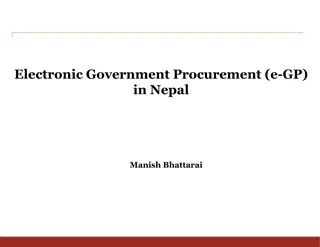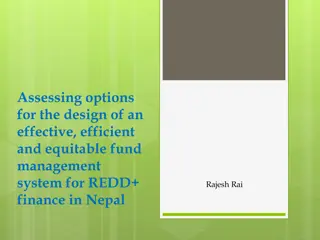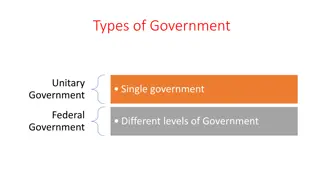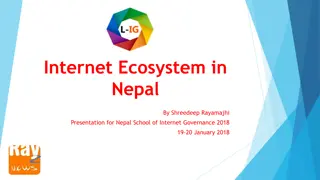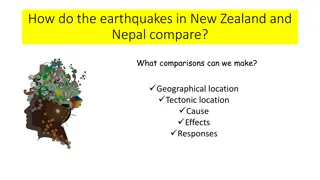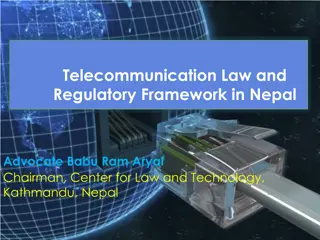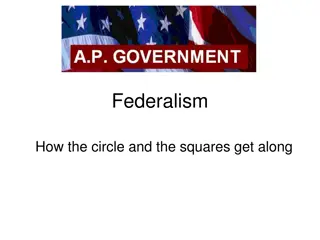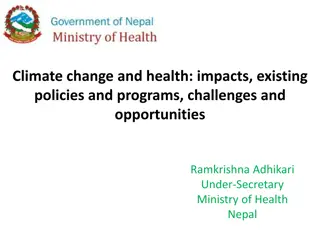State Re-structuring and Federalism in Nepal by Resham Kandel
State restructuring in Nepal involves the redistribution of power across different tiers of government and the redesign of governance structures to achieve political, economic, social, and administrative transformation. The concept focuses on decentralization, inclusivity, and proportional representation, aiming to customize and configure state machinery. Various approaches to restructuring, including devolution within unitary systems and federalism models, are explored. The goal is to eliminate discrimination, abolish feudal systems, empower marginalized communities, ensure inclusion, and logically conclude people's movements.
Download Presentation

Please find below an Image/Link to download the presentation.
The content on the website is provided AS IS for your information and personal use only. It may not be sold, licensed, or shared on other websites without obtaining consent from the author. Download presentation by click this link. If you encounter any issues during the download, it is possible that the publisher has removed the file from their server.
E N D
Presentation Transcript
State Re-structuring and Federalism in Nepal Resham Kandel
Presentation Outline State restructuring concept and practices Principles of federalism and bases of state- restructuring constitutional provisions of power sharing in Nepal Challenges and opportunities Way forward
Concept of state re-structuring Re-distribution of state power (political, economic, administrative) in different tiers of government. Re- design governance structure and mechanism. Political, economic, social and administrative transformation through decentralized, inclusive and proportional representation. Customization and configuration of state machinery. Out of four components of state, sovereignty and government are to be restructured.
Approaches of restructuring Devolution of power within unitary system: France, Indonesia, Denmark, Sweden, Norway, Japan etc. Federalism: Coming together: USA, Canada, Australia Holding together: South Africa, Ethiopia, Nepal Gradual and Big bang
Why State- restructuring ? To eliminate racial, regional, gender and economic discriminations to form an equitable and just society To abolish feudal system To mainstream marginalized community To ensure inclusion, diversity management and development To logically conclude the peoples movement and To empower the people
Bases of state re-structuring Democracy and sovereignty: Human rights, representation, free, fair and frequent election, accountability mechanism. Division of state power Autonomy and ownership Service delivery and balanced development Access and control over resources Distributive justice Inclusion and positive discrimination Unity with diversity
Bases of state re-structuring in Nepal Identity: ethnicity, culture, language, history and geography economic competence, infrastructure development, natural resources and access to public services Competency: relations and
Components of state restructuring Governance mechanism Electoral system and representation Socio economic transformation Control and ownership over government
Federalism in Nepal Unitary to federal Centralized to decentralized Exclusive to inclusive Top down to collaborative approach of development Power transfer to power sharing modality
Features of Nepali federalism Based on diversity management Co-operative federal model (Inter locked) Symmetric federalism Triple tier federal structure
Interrelationship among the tiers of Governments - Vertical and Horizontal (Judiciary Unitary system) Federal Cabinet Federal Parliament Federal Judiciary Provincial Parliament Provinci al Provincial Cabinet Judiciary Local Council Local Executive Judicial Committee Local
Systemof Federal Governance Constitution 13 Federal Government (GoN) Provincial Government Local Government DCC Rural/Urban Municipalities Ministries, Departments, Regulatory Bodies Provincial Ministries, Departments, etc. Divisional/Distri ct Offices Federal Offices/ Projects -Division/Section/Unit Service Center - Ward Office Principle: Cooperation, Co-existence, Coordination
Metropolitan Cities -6 Kathmandu, Lalitpur, Bhaktapur, Pokhara, Birgunj, Biratnagar -dxfgu/kflnsf_ Sub-Metropolitan Cities - 11 -pkdxfgu/kflnsf_ 14 / : : : : : Municipalities: 276 -gu/kflnsf _ Rural Municipalities 460 -ufpFkflnsf, s"n j8f #@!^_
Allocation of competencies Schedule 5- List of exclusive rights of federal government (35) Schedule 6- List of exclusive rights of provincial governments (20) Schedule 7- List of concurrent rights (federal and provincial governments- 25) Schedule 8- List of exclusive rights of LGs (22) Schedule 9- List of concurrent rights (Federal, Provincial and Local- 15)
Exclusive rights of central level International relationship and co-operation Monetary related issues Defense Custom duty, VAT and Income tax Mega infrastructures, national policies, plan and standards. Central administration
Major roles of provinces Province level policies and plans Provincial infrastructure development, health, educational promotion Taxation like provincial business, transportation and natural resource based. Provincial administration and civil police. Provision of provincial parliament.
Local governance Constitution has envisioned wider roles and responsibilities to local level. Direct election of Mayor/ deputy Mayor and Ward chair/ members Local assembly as local parliament ( minimum 27 to maximum162 members based on size and population of local level)
Cont Executive Board under the chair of Mayor( 9 to 36) Representation of women, indigenous, minorities and backwarded communities. Women's representation at local level is overwhelming (i.e. around 41%)
Rights and responsibilities of local assembly Discussion and approval to local law Approval of periodic plan, annual program and budget Discussion over local issues pertaining to local development and service delivery.
Rights and responsibilities of local government ( executive) Drafting and implementation of local plan, policy and budget Service delivery : regulatory services, primary health, agriculture, veterinary, forestry etc Engagement on development related activities. Local tax management Judicial role as mediator.
Inter Governmental Relation Legislative/ Legal Executive/ Administrative Judicial Financial Developmental/ Service Delivery
Guiding Laws/ Acts to PGs and LGs Constitution of Nepal Local Government Operation Act 2074 Public Procurement Act 2064 Inter-Governmental Fiscal Management Act 2074 Model Provincial/Local Planning Guideline 2075 Local Level Planning Directive 2074 Sectoral Acts/ Regulations/ Directives/Guidelines/Standards Model Acts/ Regulations
Major Challenges and Way Forward Mindsets and common understanding Institutional mechanisms (systems and procedures) at Provincial and Local Level Capacity (Individual and Institutional)of Provincial and local governments Intergovernmental coordination Local Participation and accountability

 undefined
undefined

















